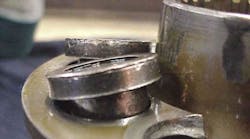As every hydraulics end-user who's been around for a while knows, hydraulic component manufacturers are notorious for the smoke and mirrors they use to deny warranty claims.
Now, this is NOT to say all warranty claims are legitimate. In fact, it's very safe to say they're not. But when a hydraulic component fails prematurely, what IS needed is accurate information, i.e. better answers than 'it's contamination'.
And the reason why is illustrated by the following story about a client of mine who had suffered a series of failures involving a particular brand of radial piston motor. When he first went to the motor manufacturer about the problem - and to pursue a warranty claim, he was told the failures were caused by contamination. So no warranty.
Not satisfied with this response, he got my books Insider Secrets to Hydraulics and Preventing Hydraulic Failures, and after studying them, conducted his own failure analysis. He came to the conclusion that the failures were nothing to do with the cleanliness (or otherwise) of the oil. So he went back to the motor manufacturer with his findings, and when pressed, the manufacturer agreed with his analysis - verbally at least. But still no warranty.
Even though the motor manufacturer agreed with his (subsequently) informed analysis of the failures, they then advised him they were being caused by a flaw in the design of the machine's hydraulic circuit.
But at this point, regardless of whether there was a problem with the circuit or not, this customer had a right to be upset with the motor manufacturer. Two reasons. The first is, contamination is the standard reason given by most pump and motor manufacturers to rid themselves of warranty claims. They know how hard it is to argue down, not least because when a pump or motor fails, there is almost always evidence of contamination damage - even though in the majority of cases the contamination has occurred after the fact, or is inconsequential to it.
And in this case, because the motor manufacturer played their contamination ace card - instead of doing an open and honest investigation into the REAL cause of the failure, the circuit problem was not discovered until the customer conducted his own failure analysis AFTER subsequent failures had occurred. Not good. And very expensive for the end-user - it cost him a six-figure sum.
My point is, hydraulics end-users don't necessarily need all their warranty claims accepted (although I'm sure they'd like that!). What they need is accurate information and better answers when things do go wrong. Because as this example illustrates, inaccurate or incomplete failure analysis can be very costly. And to discover six other costly mistakes you want to be sure to avoid with your hydraulic equipment, get "Six Costly Mistakes Most Hydraulics Users Make... And How You Can Avoid Them!" available for FREE download here.

Continue Reading
Continue Reading
BOOK 2, CHAPTER 12: Fluid Motor Circuits
March 18, 2009
Motor leakage variations
Oct. 18, 2006
Sponsored Recommendations
Sponsored Recommendations
All-In-One DC-UPS Power Solutions
March 13, 2024
Motor Disconnect Switches
March 13, 2024
Industrial Straight-Through Cable Gland
March 13, 2024
